Art & Exhibitions
At Kapwani Kiwanga’s Pavilion in Venice, Tiny Glass Beads Carry the Weight of History
Her exhibition for the Canada Pavilion at the Venice Biennale lets raw material speak for itself in a subtle yet powerful comment on global commerce.
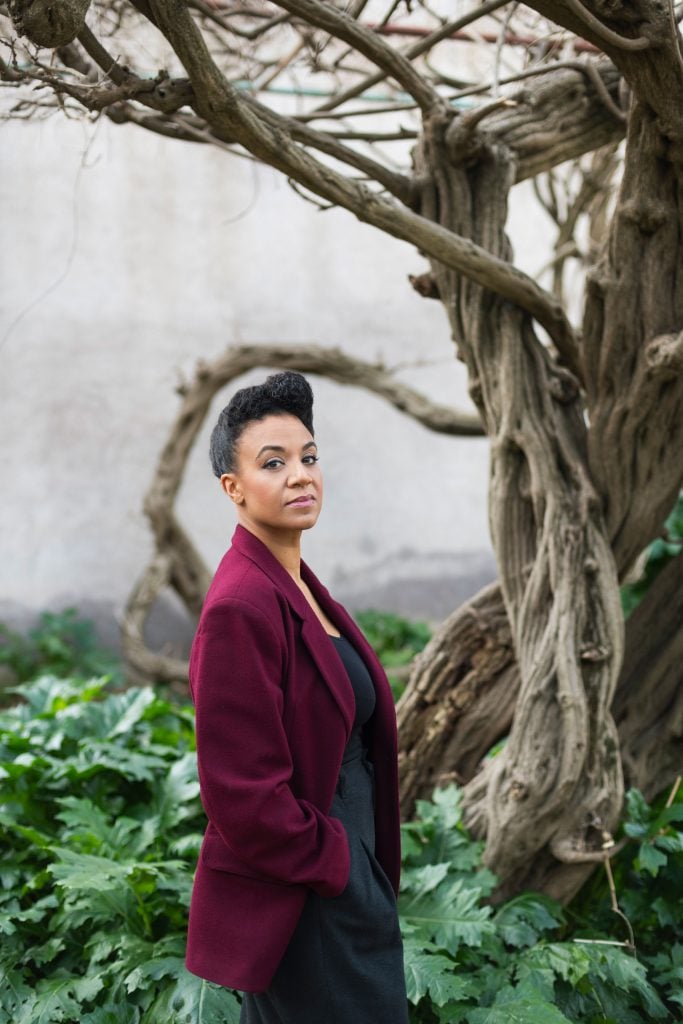
As we know from our own lives, the tiniest objects can feel, at least symbolically, extremely heavy. Artist Kapwani Kiwanga draws out this aspect—how the minute can be colossal—with an ambitious new project at the Venice Biennale, where she is representing Canada.
Called “Trinket,” the artist explores a seemingly neutral object of diminutive significance which, as Kiwanga illuminates, has shaped the world: a tiny glass bead.
These beads, which are smaller than a lentil, are deeply embedded in Venice’s history, which, as the artist points out, has deep connections with the world. Glass conterie or seed beads were used for international trade and merchants used them as exchange objects for various goods, including an array of raw materials that have been folded into Kiwanga’s poetic exhibition, which was commissioned by the National Gallery of Canada and curated by Gaëtane Verna, executive director at the Wexner Center for the Arts in Columbus, Ohio.
The Canadian artist has become well-known on the institutional circuit for her research-heavy installations and monumental sculptures that often draw on overlooked histories or explore aspects of gender, colonialism, or social injustice. She eschews the figurative, but intimate human histories are often at the heart of her highly abstracted, minimalist, and color-focused work. The Sobey Award winner has had major exhibitions at the Power Plant in Toronto, the Centre Pompidou in Paris (where she now lives and works), and Haus der Kunst in Munich.
“This tiny glass unit had such an impact, and sculpts our current world, modernity, how societies organize themselves, how they live and interact,” said Kiwanga in a recent interview, ahead of the public opening of the biennale on April 20. “It is not the only reason, but it is part and parcel with the mechanism.”
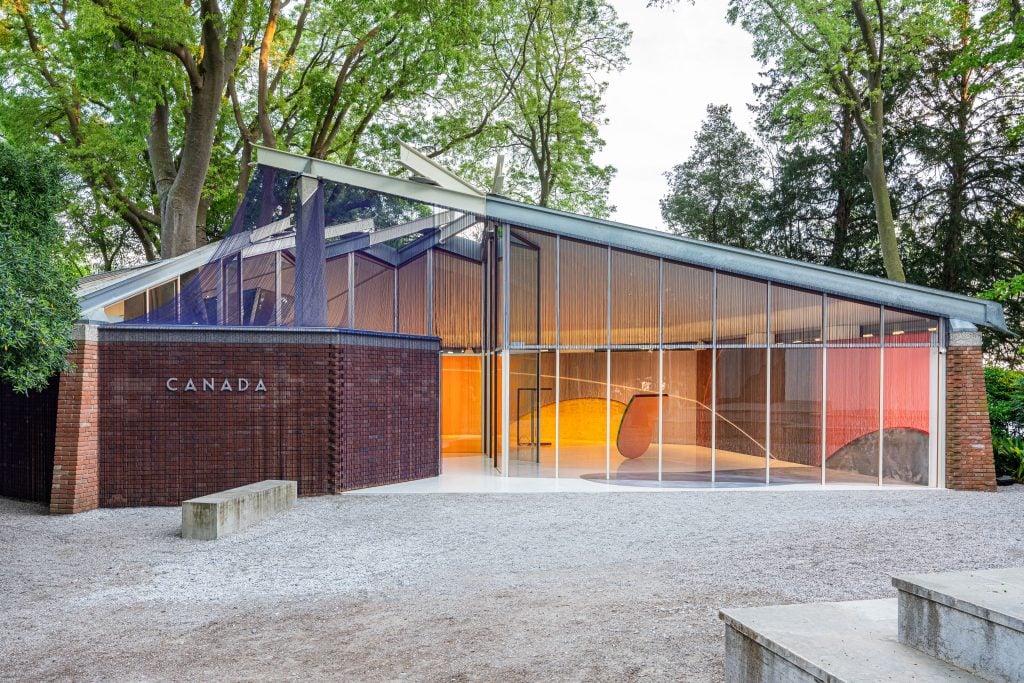
Installation view of the exhibition “Kapwani Kiwanga: Trinket,” 2024, Canada Pavilion, 60th International Art Exhibition – La Biennale di Venezia. Commissioned by the National Gallery of Canada and supported by the Canada Council for the Arts. © Kapwani Kiwanga / Adagp Paris / CARCC Ottawa 2024. Photo: Valentina Mori.
For “Trinket,” seven million beads have been strung together and assembled into a vast network of curtains, a large-scale architectural intervention that makes the pavilion feel like a single sculpture. Kiwanga aptly describes the effect as “almost alchemic”—the presentation does seem to swirl, morph, and change before you as you walk through it. Snaking around the space, these conterie are from some view points nearly invisible and from others a vibrant wash of color that sweeps through the space in a meticulously rendered gradient, moving from deep purple to yellow. The brilliant blue which encircles the exterior recalls the ultramarine hue of lapis lazuli that was at one time traded at a higher price than gold.
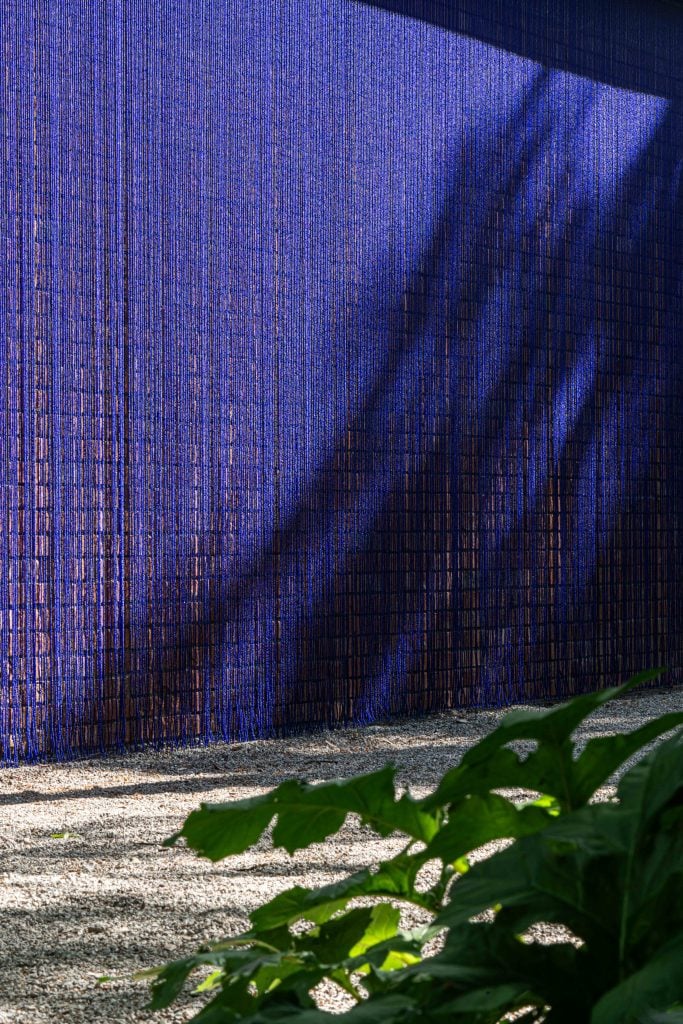
Installation view of Kapwani Kiwanga, Impiraresse (Blue), 2024. Commissioned by the National Gallery of Canada and supported by the Canada Council for the Arts © Kapwani Kiwanga / Adagp Paris / CARCC Ottawa 2024. Photo: Valentina Mori
In the most immediate sense, these tiny objects have shaped Venice. The long and esteemed history of glass-making from Murano island is highly apparent at every twist and turn along the city’s narrow streets, where there are glass art stores and glass trinket shops between nearly every gelateria or cafe. Glass sculpture—which also can be found in the windows of Venice’s exquisite churches—has long been emblematic of the city’s cultural power. But Kiwanga seeks to reattach this quality with the world—the lagoon’s flowery decorum, its intricate and opulent architecture, the sublime details around every corner, as well as the churches jammed full of art history stemming from a mercantile past when the city was a powerful player in trading for centuries—these power relations were frequently not fair.
And while tiny glass beads may not be the first thing that jumps to mind when one thinks of European trade and all its problematics, these seed beads were exchanged for gold and other precious metals. Similarly in Kiwanga’s array of free-standing abstract sculptures, the beads merge into patterns created in collaboration with Zimbabwean and Canadian artisans, adorning the edges of objects made from the raw materials that the beads were traded for throughout history, such as copper, Pernambuco wood from Brazil, and palm oil, the latter of which was used to lubricate machinery as the world hurdled towards modernity. An archway made of steel features a delicate inlay of beadwork, for example, while on the ground rests a pair of large glass sculptures in the form of a dot and a deep orange tear drop.
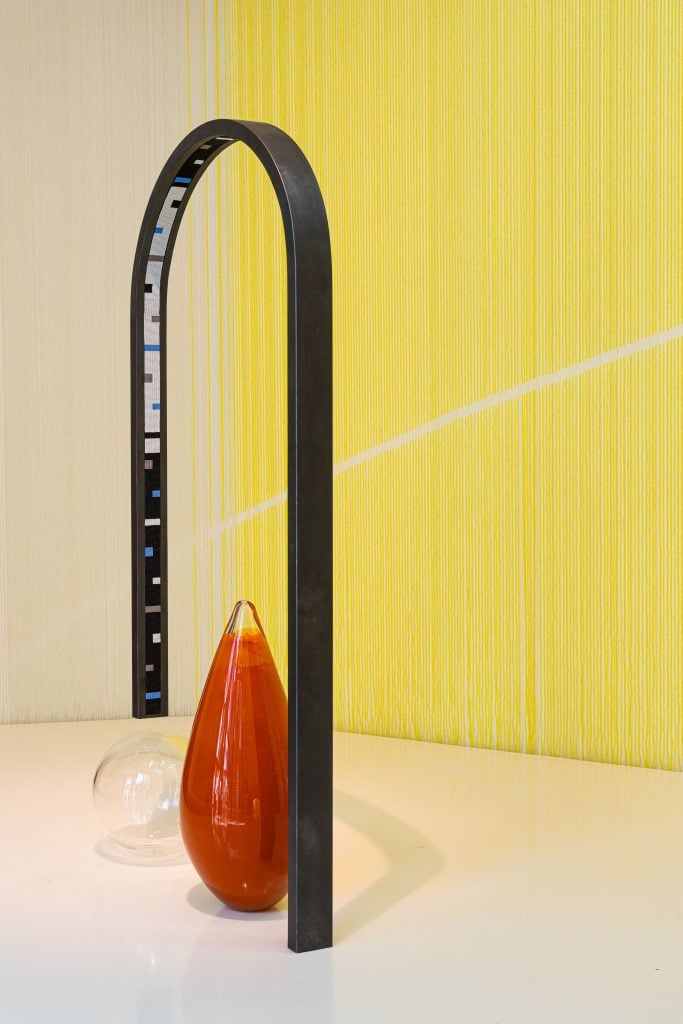
Installation view of Kapwani Kiwanga, Transfer I (Metal, breath, palm oil, beads), 2024. Commissioned by the National Gallery of Canada and supported by the Canada Council for the Arts © Kapwani Kiwanga / Adagp Paris / CARCC Ottawa 2024. Photo: Valentina Mori
The juxtaposition pushes you to consider how these beads circulated at the cultural, material, and symbolic level—and how these matrixes of meaning shifted throughout time. The value of such objects is hardly static, and materials move from the quotidian to the covetable, used for adornment in jewelry and clothes, and at once rare, sentimental, non-precious, and everyday. In this way, Kiwanga is interested in pursuing “how one material exchanged for another and how we made our architectures out of that.”
Kiwanga was trained as an anthropologist and so this form of social research is well within her wheelhouse and an essential part of her process. Her works often take on the details of history and the spaces of the present. As such, she is seasoned for the task of working within the Canadian pavilion specifically. It is not a stately space such as those built by many other nation-states in the Giardiani in the early 20th century. The Modernist building made largely from brick, and accentuated with exposed beams and glass, is one of the younger venues, erected in 1957. It is nestled between the British and German pavilions in a tree-filled corner of the biennale grounds, with some trees growing within the space itself.
“There are no right angles, there is no cube,” Kiwanga said of the pavilion. “You cannot just bring any project into that space.” She tried working with the building’s most compelling feature, a lack of boundary between the inside and the outside. “You never have a feeling that the garden is not there as with other pavilions, you cannot walk into it and be in another moment,” she added. “I figured that I would roll with that effacement.”
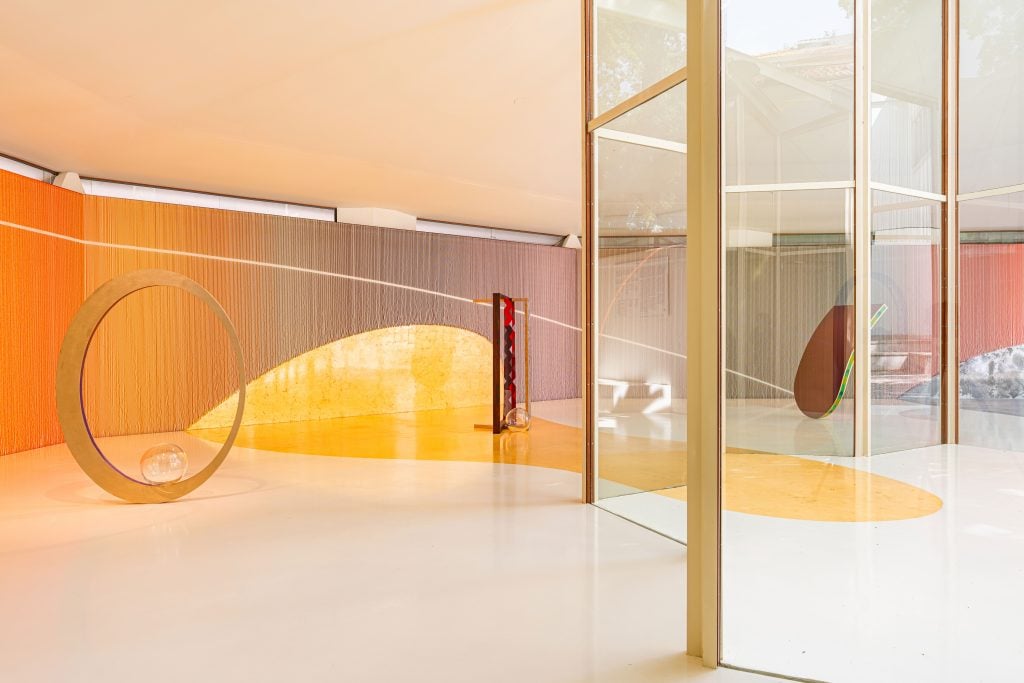
Installation view of the exhibition “Kapwani Kiwanga: Trinket,” 2024, Canada Pavilion, 60th International Art Exhibition – La Biennale di Venezia. Commissioned by the National Gallery of Canada and supported by the Canada Council for the Arts. © Kapwani Kiwanga / Adagp Paris / CARCC Ottawa 2024, Photo: Valentina Mori.
Her thoughtfulness at how to intervene delicately in a space to monumental effect is a long-standing talent. With Plot at the Haus der Kunst, presented in 2020, Kiwanga took on the heavy architectural weight of the Third Reich-era building, its hard lines and imposing interior. She draped large semi-transparent curtains around the room, creating gradients of greens and pastels that evoked the lush and manicured English Garden just beyond the museum’s doors. In the 2022 edition of the Venice Biennale, curated by Cecilia Alemani, Kiwanga presented a further development of the project for Terrarium (2022), which looked at sand as both a source material for glass and luxury, as a by-product of the oil industry, and as an indicator of an increasingly arid planet.
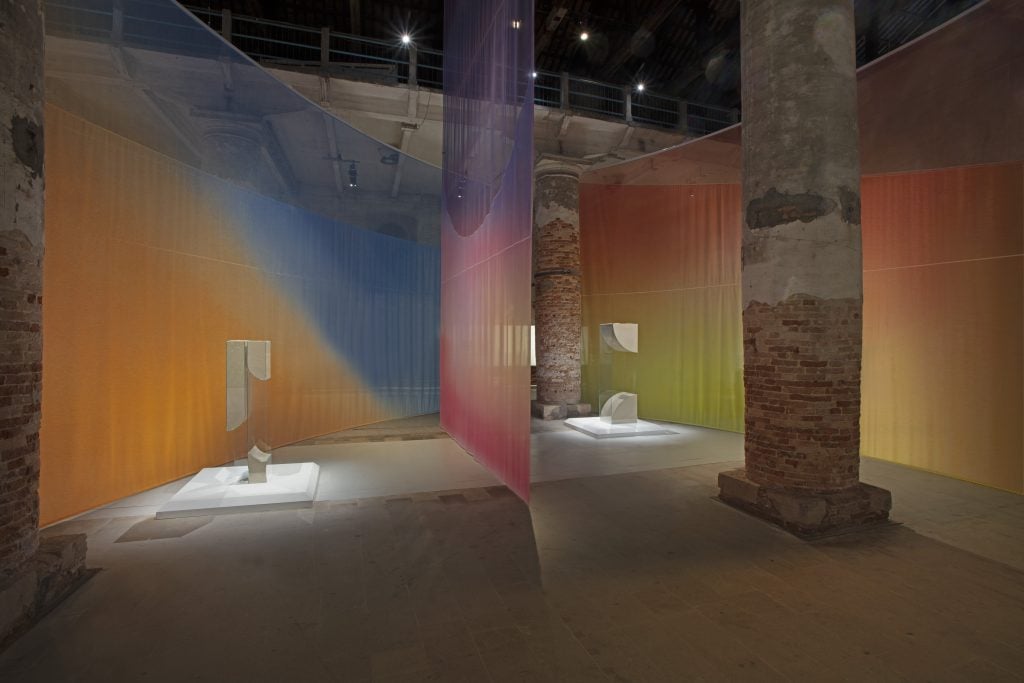
Kapwani Kiwanga, Terrarium, 2022. Exhibition view, The Milk of Dreams: 59th Venice Biennale, Arsenale, Venice, 2022. Courtesy the artist and Goodman Gallery, Cape Town, Johannesburg, London / Galerie Poggi, Paris / Galerie Tanja Wagner, Berlin © Kapwani Kiwanga / Adagp, Paris, 2023. Photo: Sebastiano Pellion di Persano
Now in the Giardini, Kiwanga took some subtle approaches to turning the pavilion inside out, removing the large wooden paneling of the building, so that its entire façade is glass. A lick of silver metal begins on the wall and spreads across the floor and extends right out the building. The curtains of beads also hang softly against the pavilions exterior walls, and drape down in the space between its slanted roof and oddly angled interior space. It’s almost as though the building is wavering gently, recalling the tides of water that lap against the sides of Venice’s canal walls, ebbing reminders that the city is not just built on today’s tourism industry—it is a port with a deep past in world trade.
One will find a sense of exhalation in “Trinket”—the materials are not pegged to any one association or connotation. They are simply able to exist and float, unbound and containing all their multitudes. “I tried to work with the bare materials so that the materiality could really stand on its own, becoming familiar,” Kiwanga said. “I wanted to let the materials speak, distilling them, and having something be present in the simplest and most elegant way.”
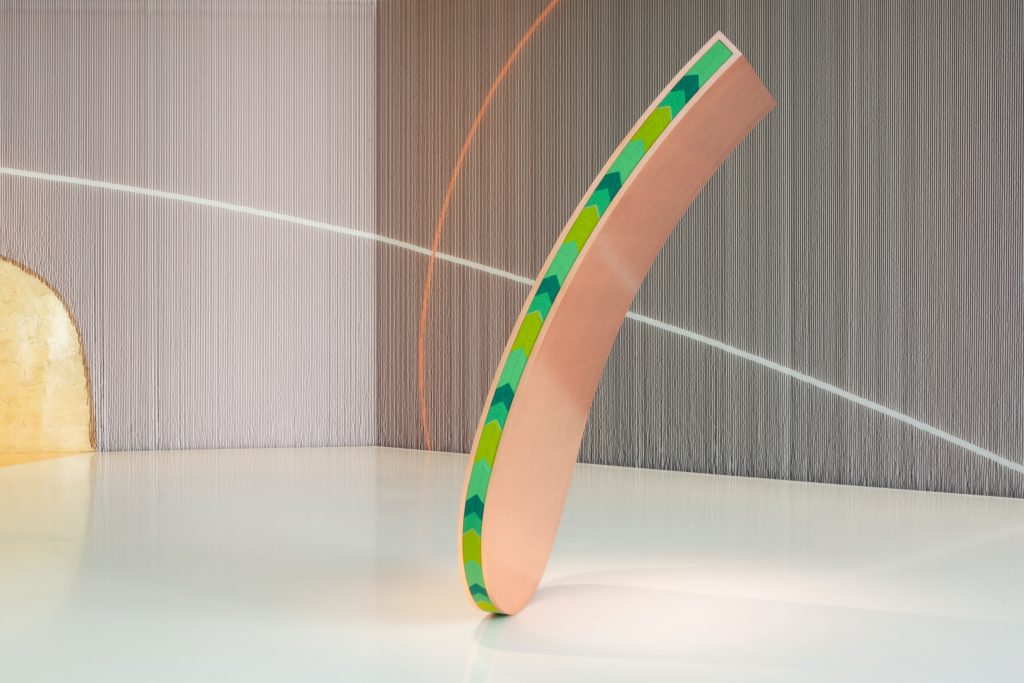
Kapwani Kiwanga, Transfer III (Metal, wood, beads), 2024. Installation view, Kapwani Kiwanga: Trinket, 2024, Canada Pavilion, 60th International Art Exhibition – La Biennale di Venezia. Commissioned by the National Gallery of Canada and supported by the Canada Council for the Arts © Kapwani Kiwanga / Adagp Paris / CARCC Ottawa 2024. Photo: Valentina Mori
The Venice Biennale international art exhibition runs from April 20 through November 24.





